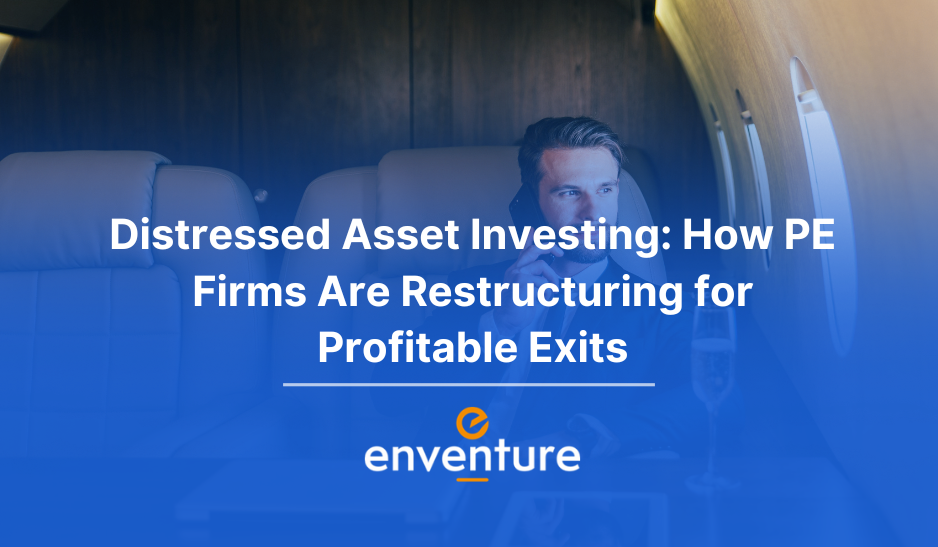Discover how PE firms turn distressed assets into profitable exits through smart restructuring, cost-cutting, and strategic turnarounds.

In the ever-evolving landscape of private equity (PE), distressed asset investing has emerged as a lucrative yet complex opportunity. As global markets grapple with economic downturns, inflationary pressures, and shifting consumer trends, underperforming companies are finding themselves at a crossroads. For savvy PE firms, this environment offers a chance to acquire struggling assets at steep discounts, implement strategic restructurings, and engineer profitable exits. This blog explores how PE firms are mastering distressed asset investing, the tactics they use, the sectors ripe for turnaround, and the risks that come with high-reward plays.
What Are Distressed Assets?
Distressed assets typically refer to companies that are facing financial hardship, operational inefficiencies, or structural disadvantages—often to the point of insolvency or bankruptcy. These assets may be undervalued due to temporary setbacks, mismanagement, or unfavorable market conditions. PE firms see potential where others see peril, betting that with capital infusion, operational expertise, and strategic restructuring, these companies can be revived.
How PE Firms Identify Distressed Opportunities
Identifying the right distressed investment is part art, part science. Here’s how PE firms go about it:
-
Financial Screening: Firms analyze financial statements to identify companies with declining revenues, high debt ratios, and negative cash flows, yet possessing underlying asset or market value.
-
Industry Insight: Sector expertise allows PE teams to distinguish between companies in temporary distress versus those in permanent decline.
-
Bankruptcy Proceedings & Auctions: PE firms closely monitor court-led sales, where distressed assets can be acquired below intrinsic value.
-
Lender Relationships: Collaborations with banks and distressed debt funds provide early visibility into potential acquisition targets.
The Restructuring Playbook: Turning Around Distressed Companies
Once acquired, the heavy lifting begins. Successful PE firms employ a robust restructuring framework to revitalize distressed businesses:
Operational Overhaul
-
Streamlining operations and supply chains
-
Cutting underperforming divisions
- Bringing in experienced turnaround management
Sectors Ripe for Distressed Investing
Several industries are currently drawing attention from PE firms in the distressed asset space:
-
Retail & Consumer Goods: Legacy brands struggling with e-commerce disruption present turnaround potential with digital reinvention.
-
Energy & Natural Resources: Volatile commodity prices have left many firms overleveraged and ripe for restructuring.
-
Healthcare Services: Operational inefficiencies and regulatory changes have burdened smaller players with rising costs.
-
Hospitality & Travel: The post-pandemic rebound still leaves many assets undervalued due to lingering debt and reduced capacity.
-
Real Estate & Construction: Interest rate hikes and delayed projects have stressed cash flows, creating buying opportunities.
Risks and Rewards of Distressed Asset Investing
Risks
-
Execution Complexity: Turnarounds require flawless execution, experienced leadership, and time.
-
Market Volatility: Economic conditions may worsen, delaying or reducing exit value.
-
Legal & Regulatory Hurdles: Bankruptcy proceedings and compliance issues can create roadblocks.
Rewards
-
Deep Discounts: Buying assets well below book value increases potential upside.
-
High IRR Potential: Successful turnarounds can yield outsized returns within 3–5 years.
-
Control & Influence: Full or majority ownership allows PE firms to implement rapid, sweeping changes.
Case Studies: Turnarounds That Paid Off
-
Sun Capital & Marsh Supermarkets (U.S.)
Sun Capital acquired the struggling grocery chain Marsh at a significant discount. Through streamlining operations and closing unprofitable stores, the PE firm returned the business to profitability before selling it to another strategic buyer.
-
Blackstone & Hilton Hotels (Global)
Although not a typical distressed buyout, Blackstone's $26 billion leveraged buyout of Hilton in 2007 faced financial turbulence during the 2008 crisis. However, strategic restructuring and global expansion helped turn the business around, culminating in a highly successful IPO in 2013.
-
Bain Capital & Toys “R” Us (Asia)
While the U.S. arm collapsed, Bain’s investment in the Asian operations of Toys “R” Us thrived. Focused restructuring and localization efforts helped these units grow, leading to a profitable exit via regional buyers.
Conclusion
Distressed asset investing is not for the faint of heart, but for private equity firms equipped with industry knowledge, operational expertise, and long-term vision, it can unlock immense value. In today’s uncertain environment, distressed deals offer a unique opportunity to drive transformation—and profit—from adversity. As more firms refine their playbooks and global markets evolve, we can expect distressed investing to remain a core pillar of PE strategies in the years ahead.
Bold Moves,
Brighter Futures
Let's team up and make a difference.
Subscribe to our newsletter
Enventure is an exit-driven fund with high-yield opportunities in the healthcare, space, and green tech sectors across the US and India.
Mail Us
3103 Kewanee Ln,
Naperville, IL, 60564
Copyright © 2025 Enventure, all rights reserved.
